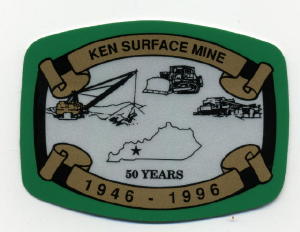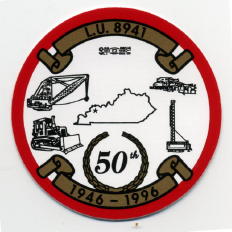|
~~ Ken Mine! ~~
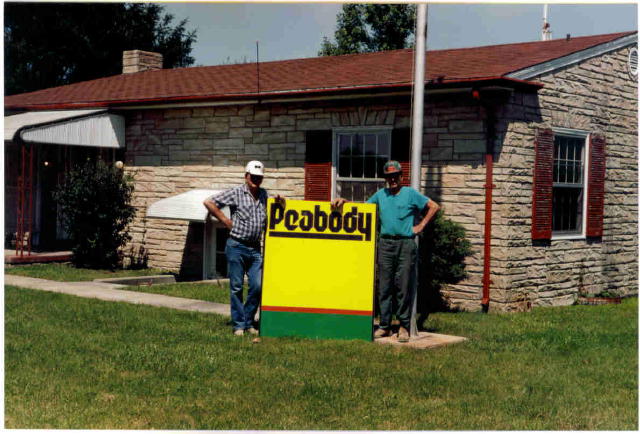
Peabody's Ken Mine Office.
Photo from Danny Southard.
Picture was probably taken in 1996. Superintendent Kenny Allen is on left and Local
union #8941 President, James Rowe is on the right..
Any time that I see a picture of Ken Mine Office, the first thing that comes to my
mind is W. A. Chancellor. W. A. may not have been the first of the miners that were
hired at Ken and may not have been the last to leave, but he is probably remembered
by more miners than anyone else. I worked at Ken mine from 1962 until 1963 and W. A.
welcomed me that first day and continued to watch over me until I was able to fend
for myself. The Ken Mine Office was unique and there is not another office quite like
it. Actually, it was a house that was converted to an office. It set alone and away
from the mine traffic and up the hill from the garage. Upon entering the office and
a small hallway, a person would enter a large room. W. A.'s desk sat in the middle
of this room and fanned out from him was the Superintendent office as well as the
other offices. To a young man just discharged from the Air Force, I was impressed
by this office complex. Some memorabilia and decorations were scattered at the entry
and around the open room of W. A.'s desk. Maps of all types seemed to be everywhere.
A few cabinets completed the decor. W. A.'s desk seemed huge to me and it held the
necessary "In-Out" type paper work as well as phones and a two-way radio mike and
receiver. Add all of this to the kind heart of a seasoned coal miner trying to help
a young miner and I was in awe. Thanks W. A.
Ken Mine-A New Era.
In Kentucky, and especially Ohio
County Kentucky, coal mining was a main source of employment in the twentieth century.
In the first half of the century, there were operational mines in just about all areas
east, south, and west of Beaver Dam. Some of these mines were owned by individuals
and others were owned by companies like Louisville Gas And Electric. The Echols Mine
was an example of a Louisville Gas and Electric owned and controlled mine. Buck Curtis
had a small mine just west of Graveyard Hill, and on Hwy. 62, between Rockport and
McHenry. This operation is an example of an individual owned mine. All of these mines
were underground mines and they had a few things in common. For instance, the miner's
work week would depend on the demand for the coal. If Louisville Gas and Electric has
a sufficient stockpile of coal for their power plants, then the mine may work only a
day or two a week or maybe no work in a week. Another common factor was the danger.
If the miner had a safety complaint, or was hesitant about doing a certain job, the
person in charge would just remind him to look outside, as there were others wanting
to take his place. The hard work, safety factor and the irregular work hours combined
to make coal mining an undesirable occupation for a lot of people. Accidental deaths,
high job turnover, low weekly pay and hard work were a few of the reasons that a lot
of the local citizens went north to find work. As the demand for coal increased, in
the mid part of the twentieth century, conditions in area coal mines were beginning
to improve. A high coal demand and an expanding Peabody Coal Company combined to create
a desirable work place. A higher than normal salary for the coal miner, and better
and safer working conditions created positions close to home for a lot of Western
Kentucky workers and the northern migration for work certainly decreased. In fact,
a reverse migration may have occurred as some of those that had to move north were
returning and finding work in the mines.
There was a vast coal reserve in Ohio County that stretched from the Little Bend area
on the Green River to Rochester and to Centertown on the Green River and from about
Beaver Dam back to Centertown, Rockport, Echols, Cool Springs and just about to the
Prentice Road. The Beaver Dam Coal Company owned the coal reserves on most of this
land and the property owners were mostly farmers. Coal had been mined in this vast
area for centuries without much of a noticeable decrease in the enormous reserve of
coal. All that was needed now was for a large coal company to enter the picture. There
is an old song with an expression in it that goes: "And along came Jones" or something
to that effect. Well, along came Ken Mine and the rest is history.
In the mid forties of the twentieth century, a small construction company was operational
in the Centertown area. They owned a small diesel powered stripping shovel and purchased
enough land and mineral rights in the Echols area to think of starting up a Strip Mine.
Bob Snodgrass along with Tom Allen and Pete Watkins worked for the Jackson Construction
Company and their new job became to move the Marion 40D diesel shovel to Echols to start
up the new mine. At about this time Frank McClain joined up with the new team and the
move was started. From Centertown to McHenry and across Highway 62,the Marion 40D was
heading for Echols. Highway 1245 was just a gravel road then and I would guess that
this shovel used a lot of the highway to complete the move. In the fall of 1946, the
Marion 40D Shovel, along with the moving crew, made the turn near Harvey's Robinson's
Grocery Store and turned on to Ken's new mining property. A few days later, the shovel
started stripping the overburden and before any coal could be moved, the Union Coal
Miners called for a strike. Pickets were set up and the mine was shut down. This
particular strike was a "Do or Die" condition for the union and it not only became
bitter, it continued for months. Although, not much blood was shed during the strike,
there was a potential for serious problems. The picket line members had readily access
to weapons and the would be "Scabs" were equally armed. Jackson Construction Company
was firm in their non-union participation and steadfastly held out until they realized
that they would probably never dig a clump of coal at this location. They sold out
to the Kesler Brothers Coal Company and soon the long and bitter battle was ended.
After a nine month strike, this new mine became a union mine. Not long afterwards,
Peabody Coal Company purchased the complete operation and a new era was started in
Ohio county.
Conditions and times were improving in Ohio County and especially in Echols and Rockport.
A small mines was in operation and no person that I am aware envisioned just what it
would mean to the Rockport end of Ohio County. Experienced miners like Jimmy Blair
and Hugh Ashton were being employed by Ken and moving to Rockport. Other small
towns in the area were also seeing new citizens move in to their town. Some of the
local residents were being hired and trained for work at the new mine. From just a
few men and one shovel, this mine continued to grow and prosper. It certainly made
Peabody Coal Company officials look good to their stock holders. Not long after the
start of the mine, a BE 1050 Shovel was brought in to do the major stripping. It
was probably a used machine, but it did not matter, Ken had a big stripper. Ken
Mine ended up being a multi-facet mine in the next two decades. The initial mined
coal was shipped out by small trucks and even the local citizens, with pick-up trucks
could be loaded with coal for their personal use. The Illinois Central Railroad
started a spur line to Ken soon after plans were laid out for the mines. The "Rail"
tipple was one of the first items to be built. A house that was on the first parcel
of land purchased was converted to an office. A large garage to handle the large
mine trucks was built just below the office. An underground mine was started and
although, it was separate from Ken, the mined coal was processed by Ken Strip Mine.
A "River" tipple, or what some would call a "Barge Loading Dock" was built and the
"Rail" tipple was reworked so that some coal washing could be done. By the late
fifties and early sixties, this mine could do it all. A Strip Mine and an Underground
Mine produced the coal that could be processed and shipped out by various means.
Initially the coal was shipped as mined. Now, it could be special ordered. Processed
coal could now be shipped out by rail, truck or river. At the peak of employment,
Ken Strip Mine may have had close to three hundred miners and the Ken Underground
may have had a hundred or more. Times were good and the "Black Gold" went out and
the "Green Dollars" came in. Prosperity was there for the asking. All good things,
in this material world, come to an end and after fifty years, Ken was approaching
that ending stage. In December of 1983 Peabody Ken Underground had shut down. In
November the twenty-eight in the year of nineteen ninety-seven the last coal run was
made at Ken Mine. A year or so later, the plug was pulled and according to the person
that pulled that plug, the write-up in the log book stated: "I killed Ken today". A
few men were left for clean-up and reclamation work and now with the other mines
closing, we were returning to "Pre-Peabody" times. A relatively large coal reserve
still exist in Ohio County and hopefully, some company will try to build another Ken
Mine.
Gosh, if you are still here after reading all of this, I appreciate your determination.
The history of Ken Mine could be written in a book with two or three volumes. I have
only touched on some of what I have experienced and of some of the men that I have
known. Where I know miners like Billy Welborn and Ed Whitehead, there are other miners
with equal attributes that I do not know. I will certainly be standing in line, when
and if, that certain person ever writes a book on Ken Mine. I have some more pictures
and some more ideas and will try to come up with a "Ken Mine Part II" if there is a
demand for a similar type web page. Actually, I have only scratched the surface of
the Ken Mine era. What would Ken Mine be without the old BE 1050 and I just barely
mentioned that big stripper? Most of you will know what I mean when I say 1050 and
others will not have any idea. Men and machines tend to bond and those in control
of the machines tend to speak and talk about them as if they were more than just a
collection of "Buckets and Bolts". All of the machines in any mine have operators
and a few of these operators have operated more than one machine. I can not remember
nor keep track of certain machines, but others can, not only tell you the official
name and the nickname of each piece of a mine machine, but the history from construction
to destruction. This is just the way it is.
Some Ken Mine Miners at the fiftieth year
anniversary of Ken Mine and of LU #8941.
From Left to Right-Tommy Southard, Frank McClain, George Devine, Pat Patterson, Dick
Thomas and Ed Whitehead...
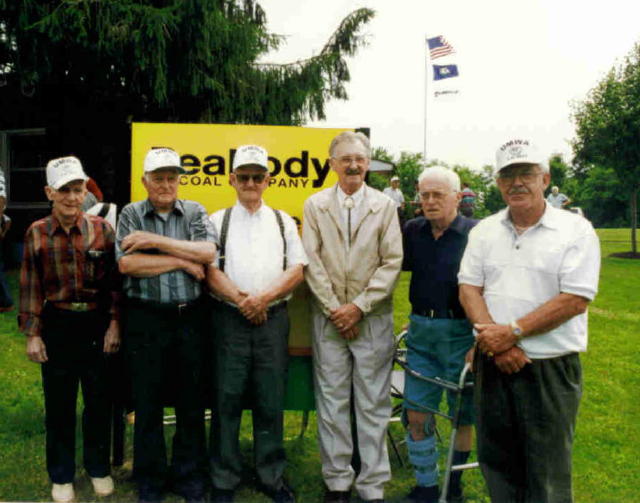 Ken Mine 50th Anniversary Celebration. Photo by Danny Southard.
Ken Mine 50th Anniversary Celebration. Photo by Danny Southard.
The above picture was taken at the Ken Mine Office in 1996 during the celebration
of the mine and the union Fiftieth Year Anniversary. Fifty years is a long time
for a strip mine to be in operation. Ken is one of just a few mines that have
accomplished this feat and it had more than a year left until the last coal run was
made on 11/28/97. Shut down and clean-up type operations extended this period for
a few more years.
The Supervisors-Past Ken Mine Superintendents.
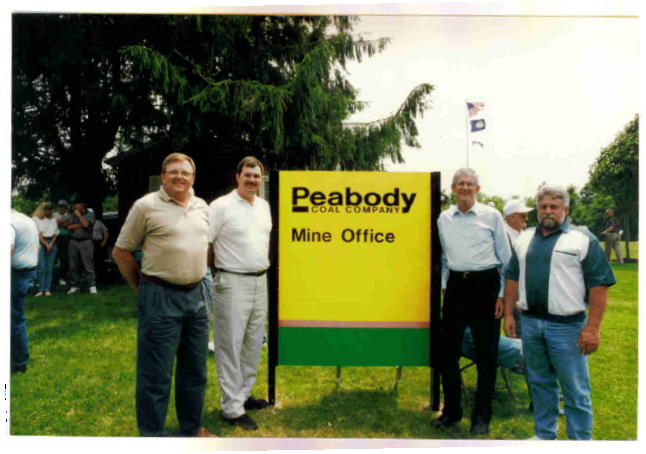
Photo furnished by Danny Southard.
During the 50th Year Anniversary Celebration, four previous Ken Mine Superintendents
were able to make the celebration. They are pictured Left To Right: Kenny Allen,
Tom Cornette, Bill Johnson, and Gene Wilson.
The Black Diamond and the pilot, George Woods.
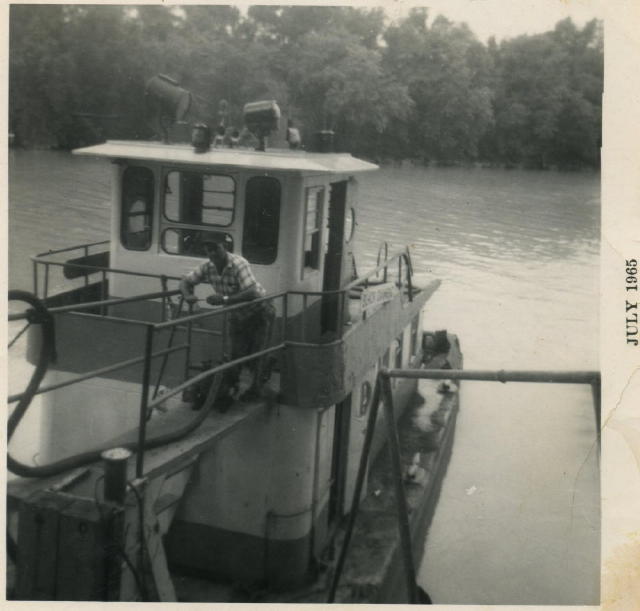
Photo from the Ray McClain Collection.
I guess from day one that Ken River Loading Dock became operational, George Woods was
the pilot of the Tug Boat that moved, sorted, and readied barges for loading as well
as for shipment. George was a fixture at the loading dock from the time that it became
operational until it was no longer used to load the river coal barges. George had several
helpers, but none seem to stay with the position as long as George stay as a pilot.
Frank McClain worked with George on the Black Diamond and Frank was one of the first
hired and close to being number one on the seniority list. I am guessing that in the
early days, there may have been more than one tug, but the Black Diamond was the only
tug that I can remember. George, like W. A. Chancellor just seemed to be a part of
Ken Mine and not very many discussions will come up on the subject of Ken Mine unless
one of those names are eventually mentioned. Way to go George.
Thanks for looking.
---------------------------
As you can see, I have covered most of the facets of the Ken Mine Operation. In
doing so, a lot of the material and information has come from aged memory cells and
these cells just are not that good. If some of you miners, or others that are familiar
with Ken Mine, would look this information over and point out any mistakes or errors,
I would certainly owe you a favor. I have not intentionally typed any material that
I know to be false, nor have I tried to misrepresent anyone. I used the pictures
that I had and I know that I have not mentioned hundreds of miners that help make
this mine what it turned out to be. I have seen a large picture of the miners in
a group picture at the Rail Tipple and also at the Garage and I would like to add
both of these pictures to this web page. I just can not take such a large picture
and resize it so that any of the miners would be recognizable. I can add a few more
pictures to this web page though and if you feel that a certain group of miners should
be added or a particular miner, feel free to send me the picture and some information
on the subject. I will see what I can do.
See you......
jrd
| |
